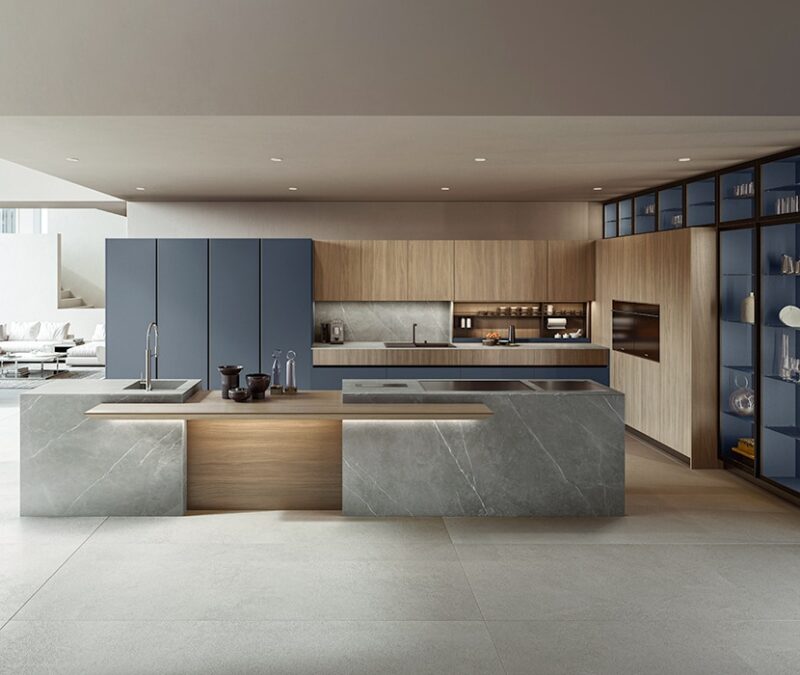Italy is a country synonymous with food, and its kitchens serve as a testament to the culinary and cooking passions Italians have. The end result is that an Italian kitchen style represents just the right balance between functionality, warmth and sophistication to transform your kitchen into more than just a place for cooking, but also a place for family and friends to gather around while you show off your culinary skills!
In this article, we will explore the essence of Italian kitchen design in greater detail; from identifying its key characteristics, to understanding the color palettes and materials that define Italian style, to providing some ideas on furniture arrangements and layout.
Since starting my career as an interior designer, I’ve had the pleasure of working on multitudes of kitchens that revel in all things Italian. Here, I’ll share my knowledge so that you have the power to whip up a space that’s as sweet as Italian design. From novice home chef to intrepid bourgeois, this will be your bible for creating an Italian-styled kitchen.
Characteristics of Italian kitchen design

The natural components of Italian kitchen interior design – stone, wood, terracotta – give the space a rustic sense of elegance, with a feel of timelessness and authenticity.
Warmth and Inviting Ambiance
Italian kitchens are designed to be welcoming and inviting, encouraging gatherings and conversations.
Such an environment can be created by employing warm colour palettes, lush materials, and atmospheric lighting.
Seamless Integration of Indoor and Outdoor Spaces
Italian design turns people out and into the landscape.
The large windows or door that is at least partially opened onto a patio or garden is the definitive mark of good flow.
Emphasis on Craftsmanship and Attention to Detail
Italian kitchens are custom-designed with detailed woodwork and handmade tiles, handcrafted by local artisans.
Every part has been chosen and lovingly crafted to reflect the values of Italian design.
Color palette and materials for an Italian kitchen

The palette of colours and materials used in an Italian kitchen is an important factor in making that space feel and look as it should. It tends to be warmer and earthier, redolent of wood, stone and terracotta – add an authenticity and timelessness that plays into the emotional response.
Color Palette
- Warm shades of yellow, terracotta, and earth tones
- Rich, deep hues like burgundy, olive green, and burnt orange
- Accents of soft blues and greens to complement the earthy tones
Materials
- Wood: Oak, cherry, and walnut are popular choices for Italian cabinetry, floors, and accents.
- Stone: Travertine, marble, and limestone are commonly used for countertops, backsplashes, and flooring.
- Terracotta: Tiles, pots, and decorative accents add a rustic charm.
- Wrought iron: Used for light fixtures, hardware, and decorative elements.
Textures and Patterns
- Exposed brick walls or tile backsplashes with intricate patterns
- Distressed or weathered finishes on wood and furniture
- Woven textiles, such as tablecloths and curtains, add warmth and character.
Furniture and layout ideas for an Italian kitchen

Italian kitchen furniture and layout are designed to provide for efficient use: Italian kitchens are designed to be in the centre of the home. Family and friends share the kitchen, preparing food together, eating family meals and having a conversation. Here is advice to have that coveted Italian kitchen layout and furniture:
Kitchen Layout
- Open floor plans that seamlessly integrate the kitchen with the living and dining areas
- Central islands or peninsulas that encourage conversation and collaboration while cooking
- Dedicated dining areas within or adjacent to the kitchen for casual meals and gatherings
Furniture Selection
- Rustic wood tables and chairs, often with distressed or weathered finishes
- Comfortable seating options, such as upholstered benches or armchairs, for relaxed dining
- Built-in cabinetry and shelving for displaying cookbooks, ceramics, and decorative accents
Appliances and Accessories
- Freestanding or built-in ranges with a classic or vintage-inspired design
- Copper or brass accents on appliances, light fixtures, and hardware
- Open shelving for displaying cookware, ceramics, and other decorative items
Lighting
- Pendant lights or chandeliers over the central island or dining area
- Recessed lighting or track lighting to illuminate work surfaces
- Candles or lanterns for creating a warm and inviting ambiance
Conclusion: Bringing Italian kitchen style into your home

Consistent with the Italian kitchen style, the secret to transforming your kitchen into an ‘Italian kitchen room’ goes beyond design itself to embrace a way of living, a way of eating, a way of gathering, and ultimately, a way of life dedicated to celebrating the pleasure of eating well, the pleasure of coming together, and the pleasure of living well. Just follow the aforementioned elements highlighted above – the warmth of shades and precious materials used for furnishing, the unpretentious yet evocative simplicity of furnishing details, the inviting elegance of the table, and the functionality of the space.
After all, an Italian kitchen is all about building relationships and creating memories, whether you’re entertaining a noisy crowd or enjoying an espresso by yourself.
After all, to me what truly matters when it comes to Italian kitchen design in Sardinia and Sicily is not how it looks, but how it feels: making us touch, see, taste, smell and feel good. Adopt to your kitchen the rhythm and colours of our traditions, give your kitchen bench some warmth by the sight of some mid-afternoon sun, oversee a room destined to become a clear witness to our vital pathways and serve the art of a better living.


